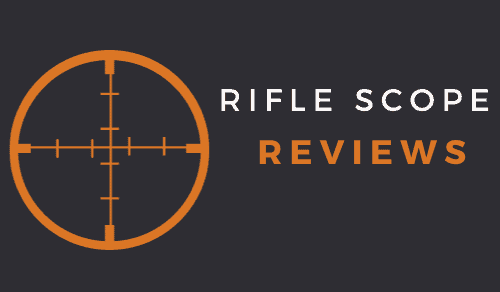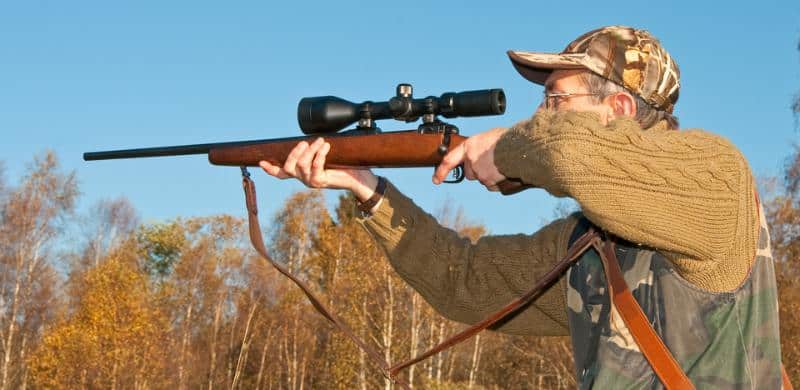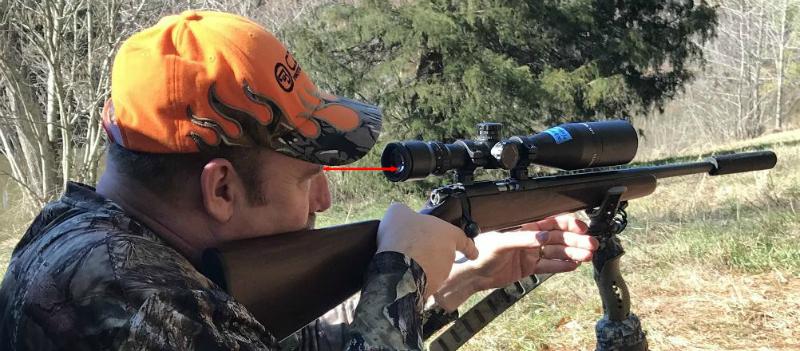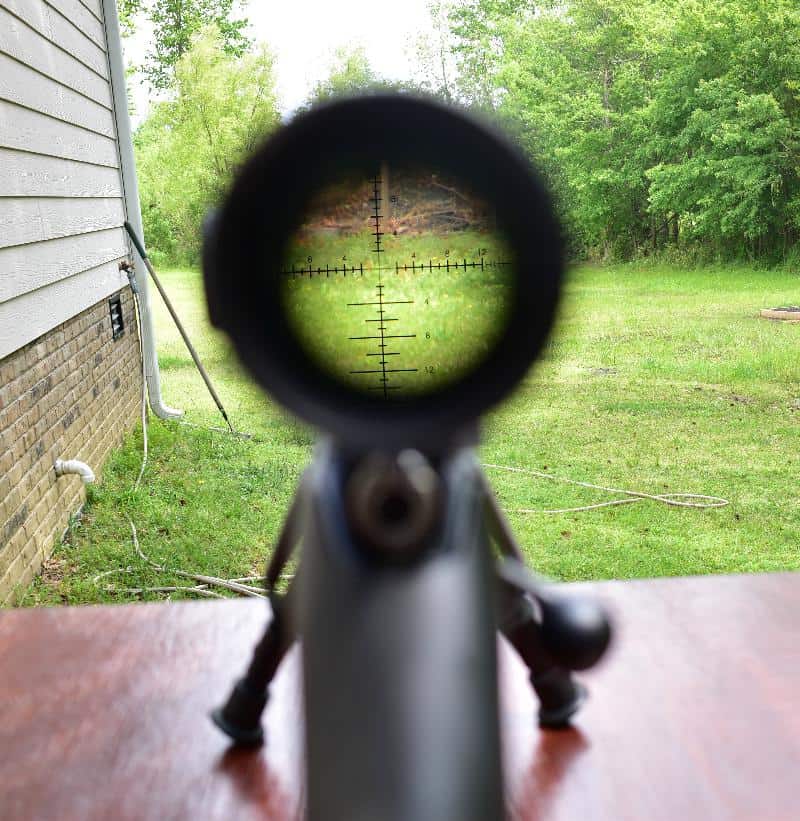As an Amazon Associate I earn from qualifying purchases. Amazon and the Amazon logo are trademarks of Amazon.com, Inc, or its affiliates.
Judging from the number of questions and emails I get regarding various aspects of rifle scopes, one of the more confusing scope related topics seems to be the concept of eye relief, and how to change or adjust it.
As such, I thought I’d take some time to go over the concept of eye relief with the following goals:
- Try to define eye relief and provide a context about how it works
- Cover the why is eye relief important question
- Discuss the process of adjusting the eye relief on a rifle scope.
What is scope eye relief?
The term “eye relief” is typically associated with some type of optics and is most normally associated with rifle scopes (my focus here), binoculars, telescopes, and microscopes.
In layman’s terms, the eye relief is the farthest distance from the closest surface of an eye piece that allows the user to see a full view through the device. And by “full view”, I mean an unobstructed view through the device.
Eye relief is normally measured in inches with rifle scopes, although there are a select few European-based scope brands that provide eye relief in millimeters.
When looking at or reviewing the manufacturer’s specifications (commonly called the “specs”), eye relief will normally be presented in a range of inches. A range is presented as no two people have the same perception of eye relief, so the range is provided as a rough gauge.
Why is eye relief important with rifle scopes?
When applied to a discussion of rifle scopes, eye relief is extremely important for one main reason: firearm recoil.
Almost every rifle or shotgun, regardless of the caliber or gauge, generates some type of recoil when a round or shell is fired. That recoil can range from next to nothing all the way up to something much more violent.
When shooting a rifle or shotgun equipped with a scope, the eye relief of the scope (along with some other factors) will play a role in how close the shooter’s face and dominant eye will be to the scope when a round is fired. If the scope has a short eye relief, say in the 2”-3” range, then the shooter may be so close when the rifle or shotgun fires that the recoil drives the scope into their face.
This phenomenon has a number of unofficial terms to describe it, but the more common ones are:
- Scope bite
- Scope eye
- Rifle tattoo
The “scope bite” description is the most common one.
Thinking back, I recall being a scope bite victim at least two times, with one bite being relatively minor one and one bite that I’ll never forget.
The never-forget one was completely my fault as, in a lapse in judgment, I was not paying attention to the small details.
In that situation, I was at the range with a buddy who was sighting in his 7mm Magnum for an upcoming elk hunt. At that time, I had not fired a 7mm Maggie before, so he offered me the chance to take a few shots to experience the caliber and verify his zero.
He and I were deep in a discussion about a deer hunting story when I sat down behind his rifle, so his story was taking up most of my attention. Now, he’s a much smaller individual than me, and I should have noticed that by the time I had adjusted my head until I could see a full field of view through the scope, my eye was only about 2 inches from the scope.
However, I did not even think twice about how close the scope was to my eye and pulled the trigger. I’m a right-handed shooter and right-eye dominant, so the recoil came straight back, driving the scope into my right eye socket.
The ocular ring of the scope connected with my ocular bone just under my right eye, and the rest of the ring went into the soft portion of my eye.
I’ll say that I only shot that rifle once, and only once.
I ended up with blood coming out of a cut just under my eye, and the impact had caused some of the blood vessels in my eye to burst, so I also had blood in my eye. Within about 3 hours, my entire eye had swollen shut, and I looked like I had gotten into the ring with Mike Tyson.
I got to see the results of my mistake in the mirror for about the next three weeks and actually became a little “gun shy” (no pun intended) about shooting higher-powered calibers.
Again, it was completely and absolutely my fault as I was not paying attention, but it was a lesson I never forgot. Today, when I get behind someone else’s rifle or shotgun, I’m paying attention to that detail.
I had a picture that someone took of me, but I haven’t been able to locate it yet. If I ever do, I’ll add it to this article.
If you want to get a visual idea of what scope bite looks like, run a search on “scope bite” in Google and then look at the Google Images tab. You’ll get the idea real fast.
The moral of my story: eye relief matters.
Now, obviously, there are many other factors that can and do come into play with scope bite other than just a short eye relief, but it’s one of the main contributing factors.
How to adjust eye relief on a rifle scope
This part gets a bit confusing as the eye relief on a scope is a fixed setting, so you have to actually move the scope either forward or backward in the ring or rings to adjust the eye relief to that specific shooter’s personal preferences.
Here’s how I usually do it:
Once the scope is temporarily mounted in the rings, have the shooter close both eyes, mount the rifle or shotgun to their shoulder, and put their face on the stock in a natural position that they would normally use. Then open both eyes and see what they immediately see through the scope with their dominant eye.
Normally, for a right-handed shooter, the dominant eye is the right eye, and for a left-handed shooter is the left eye, but there are people who are cross-eye dominant, so a RH shooter has a dominant left eye and vice-versa. This technique works for standard dominate and cross eye dominate shooters just fine.
It’s important to note what the shooter (or you if you are doing this process individually) initially sees as the dominant eye will try to re-focus or adjust if you look through the scope for more than 20 or 30 seconds.
If you (or the shooter) looks through the scope at a specific item and sees a wide dark ring around the outside of the scope, but can see the entire reticle, then the scope is too close to the shooter’s eye and needs to be away from the shooter’s eye (as in moved forward in the rings) to adjust eye relief. (see the image below)
If you look through the scope and see a dark ring around the very outside edge of the scope view and can only see a portion of the reticle, then the scope is too far away and needs to be moved in the rings back towards the shooter’s eye. (See image below)
If you or the shooter look through the scope at the target and see a full field of view of the target, then the eye relief is good, and the scope should be marked in the rings at that specific position. (See below)
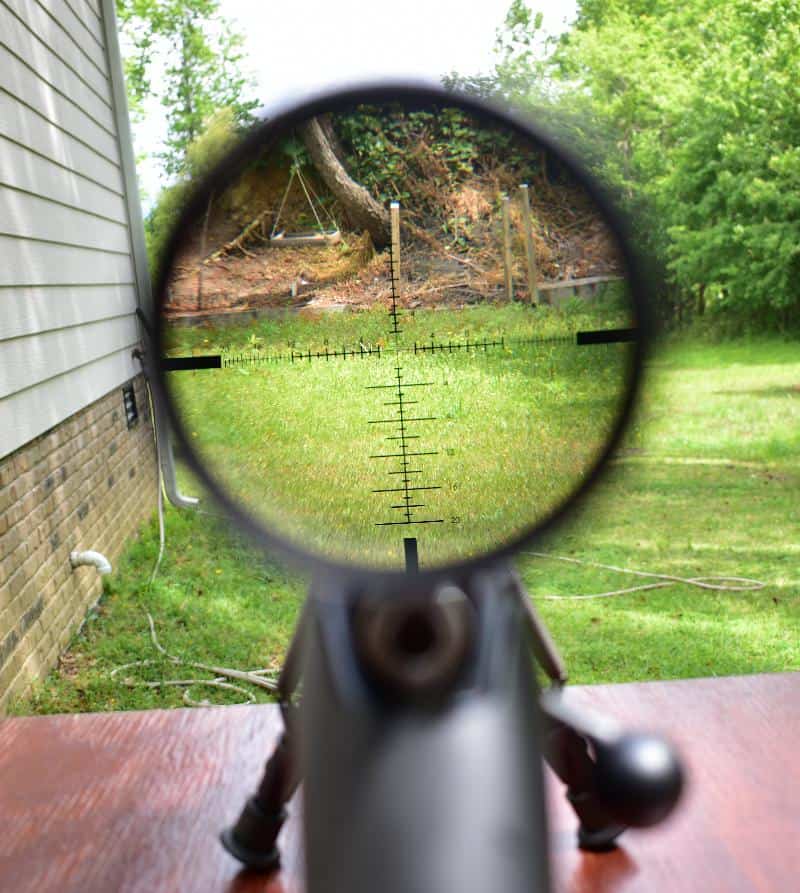
Keep repeating this process until you get the scope to the position where you or the shooter see a complete field of view without any black rings or dark spots.
Once the scope has been adjusted within the rings to the point where the eye relief is optimal, I usually mark the position in the rings with a small piece of masking tape. Then I place the rifle or shotgun back on the bench and check to ensure that the reticle is level.
If the reticle isn’t level, I’ll use either a scope level tool or another neat scope leveling tool (which I’ll share later) to gently level the reticle.
Once that’s completed, I’ll then torque the rings down to the ring manufacturer’s specifications using a scope mounting torque wrench (follow that link if you are in the market for a new torque wrench).
What is a good eye relief for a rifle scope?
Before I get into answering that question, it’s first important to understand that the eye relief specifications provided by the scope manufacturers is more of a rough gauge versus a specific science. So, if you are looking at a scope with specs saying that it has an eye relief of 3”- 4”, I’d lean more towards expecting the “actual” eye relief to be around the 3” mark.
Having looked at many, many rifle scope brands over the years, I’d estimate that the industry average for eye relief is probably around the 3” mark. Some rifle scope brands consistently offer better eye relief than others, and you generally see the eye relief options get better (as in increase) as the price ranges increase.
Now, I’m certainly not saying that you can’t get good eye relief on a scope without buying an expensive model, but you do tend to see the eye relief ranges increase as the cost of the scope increases.
When I’m scope shopping for myself, I typically won’t consider a rifle scope without a minimum of 3 inches of eye relief. Now if the glass is going on a shotgun for deer or on a higher-powered caliber, then I’ll usually increase my eye relief minimum to at least 4.5 inches. If the scope is going on something that really, really generates some recoil, then I’ll start looking for something in the 5 to 6-inch range.
Unless you’re shooting something with a bruising recoil, most shooters can get by with a scope running a 4-inch eye relief.
FAQS
Here are some frequently asked questions that I both see and hear regarding rifle scope eye relief:
What is a rifle scope eye relief extender?
The term eye relief extender is a little bit misleading as there really isn’t a way to extend the eye relief of a rifle scope beyond its factory settings. That being said, there are some places that advertise an “eye relief” extension device that consists of a rubber piece that mounts on the end of the scope and extends the scope tube another 3” inches or so. Many of these products also feature accordion-style padding to help protect the eye from recoil.
I pulled this one in from Amazon just for example purposes.
Eyeshade Tactical Optic Sight Rubber Scope Eyepiece Protector Telescope - 1PCs
While these types of devices do help to block out any ambient light from coming in around the ocular part of the scope, my experience has been that they do not actually “extend” the eye relief any past the scope’s factory settings.
Which part of the scope do I use for scope eye relief adjustment?
The scope itself does not have an eye relief adjustment that is built in. There are not any buttons or knobs, or dials that you can use to adjust the eye relief.
The scope eye relief is adjusted by moving the rifle scope either closer to the shooter’s eye or farther away from the shooter’s eye. That adjusting movement takes place within the scope rings when the scope is loosely positioned within the rings.
Can I send a scope back to the factory to have the eye relief adjusted or extended?
My official answer is not likely, but maybe. I know that the answer doesn’t make much sense, but let me explain.
Technically, this question and answer has two parts:
- If you have a scope where the eye relief ends up being significantly shorter than the factory specifications, then you may have a scope with a mechanical issue. In that scenario, it would make sense to contact the scope maker and have the scope checked out, as the eye relief may actually need to be repaired.
- If your scope has eye relief that is well within the factory specifications, but you don’t like those settings, you could contact the scope maker to see if the eye relief can be adjusted or extended.
My experience has been that most scope brands don’t engage in this kind of work as it is somewhat semi-custom, but I have heard of a few of the higher-end brands occasionally doing it.
If this was something that you were interested in, your best bet would be to contact the scope manufacturer and ask if it’s possible. The worst they can say is no.
Where can I find a long eye relief rifle scope?
Most of the upper level rifle scope brands tend to have more forgiving eye relief, and some even offer scope models that are specifically marketed as a long eye relief scope model.
Those brands include: (in no particular order and just to name a few)
- Nightforce
- Zeiss
- Vortex
- Leupold
- Meopta
- The upper end Bushnell scopes
Any of those brands would be a great place to start, but they are not the only companies that offer rifle scopes with a long eye relief.
I see people online asking about a “long eye relief scope”? Exactly what does that mean?
So, when you see shooters or hunters trying to find a scope with long eye relief, it means that they are looking for a scope that has a factory eye relief that is longer than average. This usually means they are shooting a heavy caliber and want to make sure there is plenty of room between the scope and their face while being able to get a full view through the scope.
As I’ve mentioned before on this page, typically, your best long eye relief scopes are going to be the more expensive models within a brand. Now, that’s not always the case, but it’s more common.
What is the best long eye relief rifle scope on the market?
Have you ever been asked a question that is almost impossible to answer as the answer is more opinion versus fact? Well, this is one of those questions.
While I can’t honestly tell you which specific scope model has the absolutely best long eye relief, I can tell you that, in my experience, the Nightforce brand of scopes offers some of the longest eye relief that I’ve experienced for the money.
As I come across more eye relief-related questions, I’ll add them to the page.
I’ve been working in the firearms and sporting optics industry for over 20 years, with a personal and professional interest in all things related to rifle scopes, Through a combination of work experience, formal training, and personal experiences, I have extensive experience mounting, testing, and evaluating different rifle scope models across most major optical brands.
